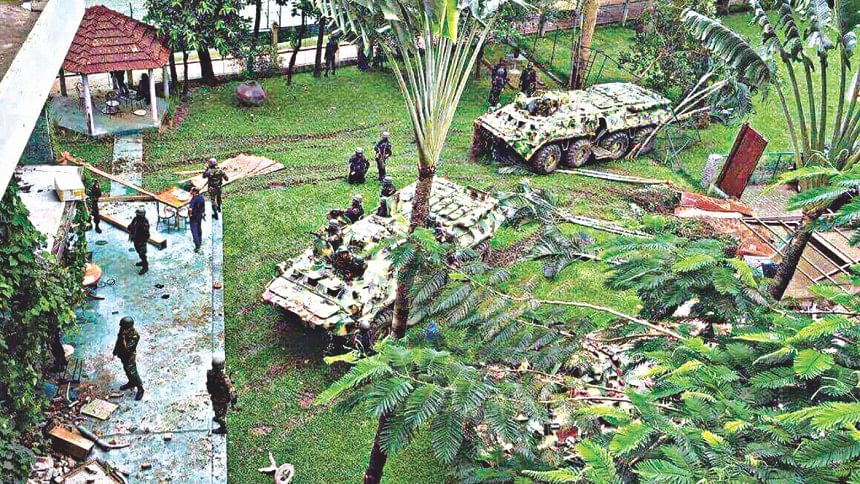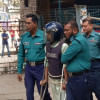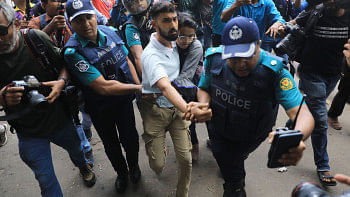Gulshan Café Attack Investigation: Tracking new terror network

The Gulshan café attack investigation helped law enforcers get crucial leads on a new web of radicals and subsequently launch a series of successful operations ripping apart the network of militancy in Bangladesh.
The preemptive drives caused a huge dent in the strength of IS-inspired “Neo JMB”, which had perpetrated the July 1, 2016 attack at the Holey Artisan Bakery in Gulshan.
A major success came 26 days after the incident, as law enforcers launched operation “Storm 26” at a den in the city’s Kalyanpur in which nine militants of the group were killed and one was arrested.
Documents seized from the den and information gathered subsequently helped law enforcers prevent three attacks planned by “Neo JMB”, which was little known to law enforcers, say DMP’s Counter Terrorism and Transnational Crime (CTTC) unit officials.
“It was the operation through which we fought back against militancy, and it was a turning point for us,” CTTC unit chief Monirul Islam had said earlier about the Kalyanpur raid.
Then came another big success as the mastermind of the café attack, Bangladesh-born Canadian citizen Tamim Ahmed Chowdhury, along with his two close accomplices were killed in a drive at a den in Narayanganj on August 27, 2016.
“When we started investigating the Gulshan café attack, we got information about the terror network, which led to our successful operations one after another,” CTTC Deputy Commissioner Saiful Islam told The Daily Star recently.
The Holey Artisan siege, the country’s worst-ever terror attack, had left 20 hostages, including 17 foreigners, killed. Two police officials also got killed after they responded immediately.
Besides, five attackers and a restaurant staffer died during the “Operation Thunderbolt” that brought an end to the nerve-racking 12-hour hostage crisis at the posh eatery. Another café staff, who was arrested on suspicion, later died at a hospital allegedly due to torture.
After the café siege, law enforces carried out 28 high-risk anti-militancy operations in which 79 militants were killed and a huge stash of explosives was destroyed or seized. Besides, more than 250 militants have been arrested since then, officials said.
Saiful said almost all leaders and decision makers of the militant group had either been arrested or got killed in anti-militancy drives. It has been weakened to a great extent, he added.
After around two years of investigation, police pressed charges against eight of the 21 militants involved in the Holey Artisan siege. Thirteen of them were killed in different drives.
After around one and a half years of trial proceedings, a tribunal in Dhaka fixed November 27 to deliver the verdict of the case.
‘PARADIGM SHIFT’
According to CTTC chief Monirul, Holey Artisan attack was a “paradigm shift” in militancy in the context of Bangladesh.
Earlier, it was a worldwide notion that those who are religiously educated or uneducated and from poverty-ridden families usually join militancy.
But because of internet and other modern technology and easy availability of radical propaganda online, well-educated people, especially youths from English-medium and posh institutions, started getting into militancy.
The breakaway group Jama’atul Mujahideen Bangladesh, “Neo JMB” as law enforcers call it, recruited physicians, engineers, architects, technologists and other professionals. More quipped with technology, it communicated using encrypted apps.
Law enforcers started to have a clear picture of this new breed of radicals and their leadership after the Holey Artisan attack.
Of the five gunmen who stormed the Gulshan café, Nibras Islam and Rohan Imtiaz were students of Turkish Hope and Scholastica schools. Both of them also went to Monash University in Malaysia.
Another gunman, Meer Saameh Mubasheer, was due to take his A-level exams as a private candidate, when he went missing from Gulshan in February 2016.
“So our focus shifted as youths from any background may now join militancy,” added the CTTC chief.
‘THREATS STILL THERE’
Though successful operations have contained militancy, threats, though not big, are is still there. Islamist radicals are still active online to spread their ideology and make recruitments, said counterterrorism officials.
They said the Neo JMB now has no charismatic leaders, hardcore activists, financiers, planners, organisers or motivators. The group also does not have the supply of arms and ammunition.
“Still”, CTTC Deputy Commissioner Saiful said, “The terrorist group can conduct small operations if they get the chance.”
Members of a “Neo JMB” cell planted improvised explosive devices (IEDs) at two places and attacked policemen at three other spots in the capital this year. The CTTC unit arrested some of the attackers in Narayanganj in September.
CTTC unit chief Monirul yesterday said the number of terrorist incidents has come down by 90 percent last year from that in 2016. But radicalisation is on the rise.
He said they have planned a huge campaign from July 1 to June next year when they will organise six programmes in each of 32 districts for madrasa teachers and students, public representatives, officials in the administration, teachers and students of schools, colleges and universities, police and jail guards and civil society members and media people to create awareness.
“Cyberspace is the single largest platform for radicalisation. To fight it we now have a state-of-the-art digital forensic lab which has the capacity to conduct forensic tests of even a drone,” Monirul said, adding they also have been getting other equipment and proper training.
Militancy analyst Shahab Enam Khan observed after the café attack law enforcers have built up three capacities.
Firstly, they have improved substantial understanding of detection. Secondly, law enforcement agencies are building interface with the community as tackling radicalisation has to be community-led. Thirdly, there is sharing of intelligence among agencies.
Shahab, an international relations professor at Jahangirnagar University, also said the current state of militancy in Bangladesh is manageable, but there is no reason to be complacent over this.

 For all latest news, follow The Daily Star's Google News channel.
For all latest news, follow The Daily Star's Google News channel. 







Comments